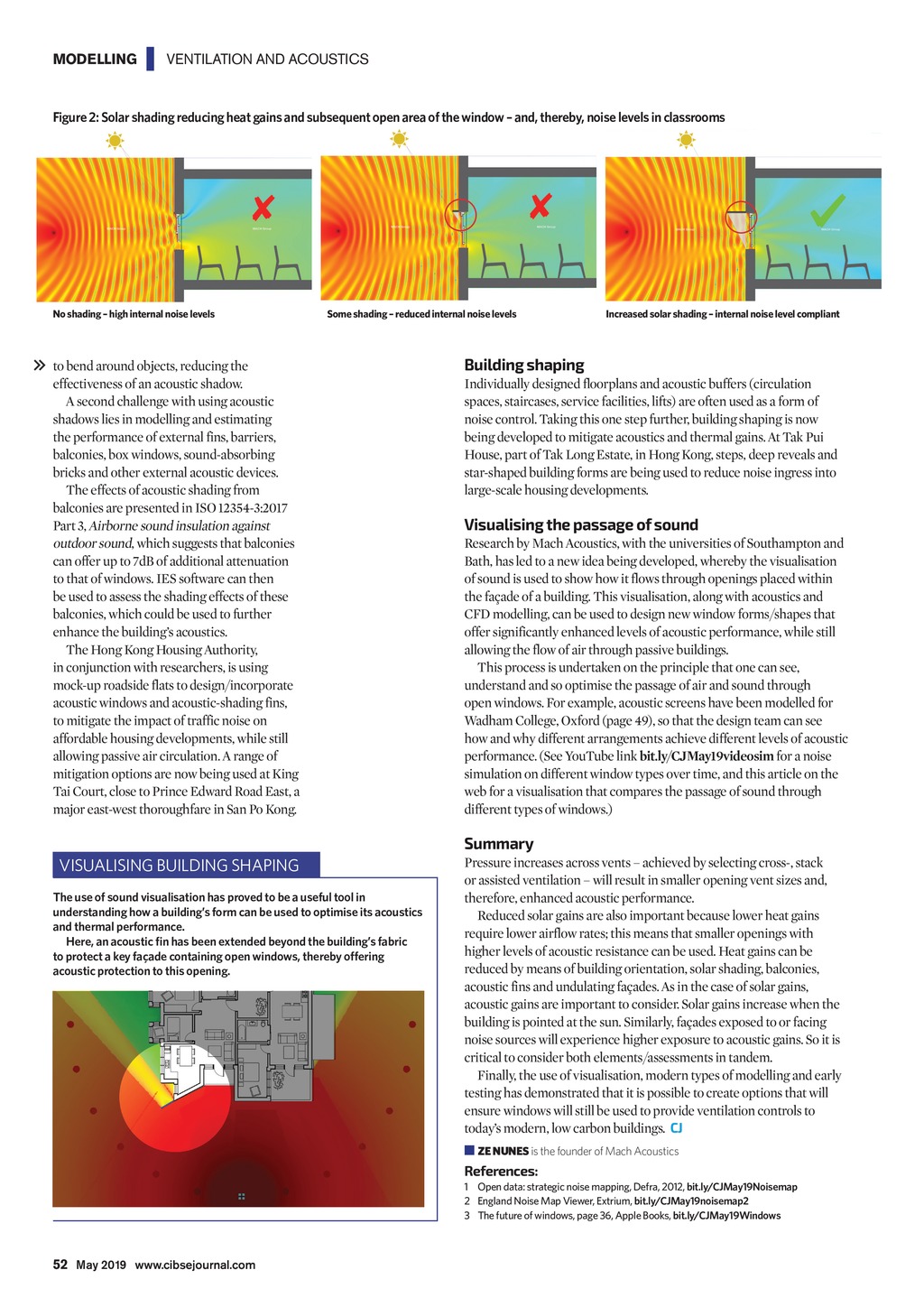




MODELLING | VENTILATION AND ACOUSTICS Figure 2: Solar shading reducing heat gains and subsequent open area of the window and, thereby, noise levels in classrooms No shading high internal noise levels Some shading reduced internal noise levels to bend around objects, reducing the effectiveness of an acoustic shadow. A second challenge with using acoustic shadows lies in modelling and estimating the performance of external fins, barriers, balconies, box windows, sound-absorbing bricks and other external acoustic devices. The effects of acoustic shading from balconies are presented in ISO 12354-3:2017 Part 3, Airborne sound insulation against outdoor sound, which suggests that balconies can offer up to 7dB of additional attenuation to that of windows. IES software can then be used to assess the shading effects of these balconies, which could be used to further enhance the buildings acoustics. The Hong Kong Housing Authority, in conjunction with researchers, is using mock-up roadside flats to design/incorporate acoustic windows and acoustic-shading fins, to mitigate the impact of traffic noise on affordable housing developments, while still allowing passive air circulation. A range of mitigation options are now being used at King Tai Court, close to Prince Edward Road East, a major east-west thoroughfare in San Po Kong. Increased solar shading internal noise level compliant Building shaping Individually designed floorplans and acoustic buffers (circulation spaces, staircases, service facilities, lifts) are often used as a form of noise control. Taking this one step further, building shaping is now being developed to mitigate acoustics and thermal gains. At Tak Pui House, part of Tak Long Estate, in Hong Kong, steps, deep reveals and star-shaped building forms are being used to reduce noise ingress into large-scale housing developments. Visualising the passage of sound Research by Mach Acoustics, with the universities of Southampton and Bath, has led to a new idea being developed, whereby the visualisation of sound is used to show how it flows through openings placed within the faade of a building. This visualisation, along with acoustics and CFD modelling, can be used to design new window forms/shapes that offer significantly enhanced levels of acoustic performance, while still allowing the flow of air through passive buildings. This process is undertaken on the principle that one can see, understand and so optimise the passage of air and sound through open windows. For example, acoustic screens have been modelled for Wadham College, Oxford (page 49), so that the design team can see how and why different arrangements achieve different levels of acoustic performance. (See YouTube link bit.ly/CJMay19videosim for a noise simulation on different window types over time, and this article on the web for a visualisation that compares the passage of sound through different types of windows.) Summary VISUALISING BUILDING SHAPING The use of sound visualisation has proved to be a useful tool in understanding how a buildings form can be used to optimise its acoustics and thermal performance. Here, an acoustic fin has been extended beyond the buildings fabric toprotect a key faade containing open windows, thereby offering acoustic protection to this opening. Pressure increases across vents achieved by selecting cross-, stack or assisted ventilation will result in smaller opening vent sizes and, therefore, enhanced acoustic performance. Reduced solar gains are also important because lower heat gains require lower airflow rates; this means that smaller openings with higher levels of acoustic resistance can be used. Heat gains can be reduced by means of building orientation, solar shading, balconies, acoustic fins and undulating faades. As in the case of solar gains, acoustic gains are important to consider. Solar gains increase when the building is pointed at the sun. Similarly, faades exposed to or facing noise sources will experience higher exposure to acoustic gains. So it is critical to consider both elements/assessments in tandem. Finally, the use of visualisation, modern types of modelling and early testing has demonstrated that it is possible to create options that will ensure windows will still be used to provide ventilation controls to todays modern, low carbon buildings. CJ ZE NUNES is the founder of Mach Acoustics References: 1 O pen data: strategic noise mapping, Defra, 2012, bit.ly/CJMay19Noisemap 2 England Noise Map Viewer, Extrium, bit.ly/CJMay19noisemap2 3 The future of windows, page 36, Apple Books, bit.ly/CJMay19Windows 52 May 2019 www.cibsejournal.com CIBSE May19 pp49-50, 52 Acoustics ventilation modelling.indd 52 26/04/2019 17:13